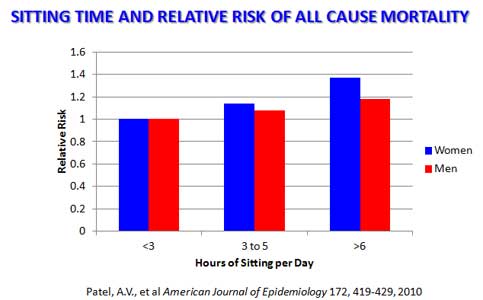- Time sitting correlates with increased all-cause mortality.
- Time exercising does not offset deleterious effects of prolonged sitting.
- Replacing sitting with nearly any other activity increases patients’ health.
- Time standing, walking, cleaning, gardening, or partaking in a host of other, common activities reduces risk of morbidity and mortality.
Every doc likes to have one bit of advice in his or her pocket to offer any patient who asks, “What can I do to be healthier?”
Here’s something you can tell any patient you encounter that will make them healthier today: sit less.
Sadly, the opposite is true: Time sitting correlates strongly with morbidity and mortality. You can tell a patient -- with data behind you -- that the longer they sit, the sooner they’ll die. (See Figure.)
How hazardous? Think morbid obesity, uncontrolled hypertension, depression, or divorce. People who sit for extended periods in their lifetimes are at significantly higher risk of morbidity and all-cause mortality.
The good news is that the solutions are simple and plentiful. All you have to do is teach patients to sit less. Of course, for the crafty physician, there are many ways to put this:
- Stand more.
- Walk more.
- Play tennis or golf.
- Go bowling.
- Join a walking or running group or club.
- Exercise more.
- Do more house work.
- Do more yard work.
- Park your car farther from your office or train/bus stop.
- Use a standing desk at work.
- Use a laptop placed on a standing-level surface while you work.
- Look to your city’s website for activities offered by the city. Residents often get optimal pricing on (non-sedentary; not book club, or knitting) classes, leagues, etc.
What these diverse activities have in common is that they can induce your patient to sit less. In a best-case scenario the patient might get some additional exercise simply because of your recommendation to sit less. However, it has been shown that time exercising does not offset the deleterious effects of time spent sitting. Patients can and should exercise, but they simply must sit less.
The Lethality of Sitting
A systematic review and meta-analysis published in Annals of Internal Medicine (2015;162:123-32) found that “Prolonged sedentary time was independently associated with deleterious health outcomes regardless of physical activity.”
Specifically, these researchers examined 47 studies and found that significant hazard-ratio associations between prolonged sedentary time and all-cause mortality, cardiovascular disease mortality, cardiovascular disease incidence, cancer mortality, cancer incidence, and incidence of type-2 diabetes. Hazard ratios for these incidents were generally inversely correlated with physical activity.
A large prospective questionnaire study of more than 220,000 Australian adults (Prev Med. 2014:69:187-91) found “a dose-response association between standing time and all-cause mortality in Australian adults aged 45 years and older.” They suggested that “Increasing standing may hold promise for alleviating the health risks of prolonged sitting.”
The Simplicity of Intervention
A study published in Medicine and Science in Sports and Exercise (2015; Jan 26. [Epub ahead of print]) reported data on more than 154,000 people who took part in the NIH-AARP Diet and Health Study.
Among this population, 12,201 people died during the observation period of nearly 7 years. The researchers found that “greater sitting time (≥12h/d vs. <5h/d) was associated with increased risk for all-cause and cardiovascular mortality.”
The good news is that they found that “in less active adults (<2h/d total activity), replacing one hour of sitting per day with an equal amount of activity was associated with lower all-cause mortality for both exercise and non-exercise activities, including household chores, lawn and garden work, and daily walking.”
Among more active people – those who engaged in 2 or more hours per day of total activity, “replacement of sitting time with purposeful exercise was associated with lower mortality, but not with non-exercise activity.”
Image credit: http://beforeitsnews.com/green-living/2012/04/can-too-much-sitting-be-hazardous-for-your-health-1993050.html.
